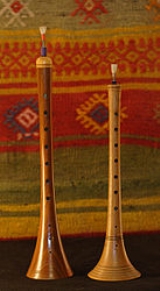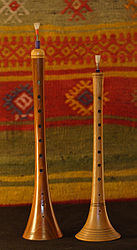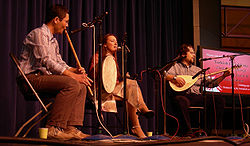
Turkish folk music
Encyclopedia

Anatolia
Anatolia is a geographic and historical term denoting the westernmost protrusion of Asia, comprising the majority of the Republic of Turkey...
and the Ottoman
Ottoman Empire
The Ottoman EmpireIt was usually referred to as the "Ottoman Empire", the "Turkish Empire", the "Ottoman Caliphate" or more commonly "Turkey" by its contemporaries...
territories in Europe
Europe
Europe is, by convention, one of the world's seven continents. Comprising the westernmost peninsula of Eurasia, Europe is generally 'divided' from Asia to its east by the watershed divides of the Ural and Caucasus Mountains, the Ural River, the Caspian and Black Seas, and the waterways connecting...
and Asia
Asia
Asia is the world's largest and most populous continent, located primarily in the eastern and northern hemispheres. It covers 8.7% of the Earth's total surface area and with approximately 3.879 billion people, it hosts 60% of the world's current human population...
. Its unique structure includes regional differences under one umbrella.
Varieties of style, scales, and rhythm
Music accompanied by words can be classified under the following headings: TürküTürkü
Türkü, literally "of the Turk", is a name given to Turkish folk songs as opposed to şarkı. In contemporary usage, the meanings of the words türkü and şarkı have shifted: Türkü refers to folk songs originated from music traditions within Turkey whereas şarkı refers to all other songs, including...
(folksongs), Koşma (free-form folk songs about love or nature), Semai (folk song in Semai poetic form), Mani (a traditional Turkish quatrain form), Destan (epic), Deyiş (speech), Uzun Hava (long melody), Bozlak (a folk song form), Ağıt (a lament), Hoyrat, Maya (a variety of Turkish folksong), Boğaz Havası (throat tune), Teke Zorlatması, Ninni (lullaby), Tekerleme (a playful form in folk narrative), etc. These are divided into free-forms or improvisations with no obligatory metrical or rhythmic form, known as "Uzun Hava", and those that have a set metrical or rhythmic structure, known as "Kırık Havalar" (broken melodies). Both can also be employed at the same time.
Music generally played without words, and dance tunes, go by the names Halay, Bengi, Karşılama, Zeybek
Zeybek
The zeybek is a form of folk dance peculiar to Western Anatolia in Turkey. It is named after the Zeybeks. The Greek popular dance of a similar name has different roots from the Turkish zeybek dance....
, Horon, Bar, etc.
Each region in Turkey has its own special folk dances and costumes.
Here are some of the most popular:
- Horon (HoraHoraHora is a type of circle dance originating in the Balkans but also found in other countries. The name is cognate to the Greek χορός : 'dance' which is cognate with the ancient Greek art form of χορεία; see Chorea. The original meaning of the Greek word χορός may have been 'circle'...
) - This Black SeaBlack SeaThe Black Sea is bounded by Europe, Anatolia and the Caucasus and is ultimately connected to the Atlantic Ocean via the Mediterranean and the Aegean seas and various straits. The Bosphorus strait connects it to the Sea of Marmara, and the strait of the Dardanelles connects that sea to the Aegean...
dance is performed by men only, dressed in black with silver trimmings. The dancers link arms and quiver to the vibrations of the kemenche (an instrument similar to violin).
- Kaşık Oyunu - The Spoon Dance is performed from KonyaKonyaKonya is a city in the Central Anatolia Region of Turkey. The metropolitan area in the entire Konya Province had a population of 1,036,027 as of 2010, making the city seventh most populous in Turkey.-Etymology:...
to SilifkeSilifke-Antiquity:Located a few miles from the mouth of the Calycadnus River, Seleucia was founded by Seleucus I Nicator in the early 3rd century BCE, one of several cities he named after himself. It is probable that there were already towns called Olbia and Hyria and that Seleucus I merely united them...
and consists of gaily dressed male and female dancers 'clicking' out the dance rhythm with a pair of wooden spoons in each hand.
- Kılıç Kalkan - The Sword and Shield Dance of Bursa represents the Ottoman conquest of the city. It is performed by men only, in Ottoman battle-dress, who dance to the sound of clashing swords and shields, without music.
- ZeybekZeybekThe zeybek is a form of folk dance peculiar to Western Anatolia in Turkey. It is named after the Zeybeks. The Greek popular dance of a similar name has different roots from the Turkish zeybek dance....
- In this AegeanAegean IslandsThe Aegean Islands are the group of islands in the Aegean Sea, with mainland Greece to the west and north and Turkey to the east; the island of Crete delimits the sea to the south, those of Rhodes, Karpathos and Kasos to the southeast...
dance, dancers, called "efe", symbolize courage and heroism.
Scales
Although some of the scales ('ayak' - foot) employed in Turkish folk music melodies are similar to the some of the 'makam' scales of traditional Ottoman/Turkish Classical Music, not all of the folk music scales have Classical music counterparts, and there are important differences between the two concepts. The 'makam' of Turkish Classical Music is not just a scale, but has certain rules of progression, which in some cases are quite detailed, and in the course of the development the whole scale of the makam is used. Though sometimes referred to as makams by exponents of Turkish Classical Music, the scales of Turkish Folk Music are more properly called 'ayak' (foot) and are simply scales, with no rules of progression, thus bearing closer comparison with the concept of medieval church modes than do makams. Furthermore in many Turkish folk songs only part of the scale is used. Both forms of music are diatonic, but use notes that are additional to the 12 semitones of western music. In Turkish folk music, for example, some scales include the note B, others B flat, and still others a note roughly halfway between B and B flat.The scales of Turkish folk music are associated with different regions, and can be known by different names depending on the region, such as: Beşiri, Garip, Kerem, Misket
Misket
Misket is a type of dance/folk music from the Ankara, and Aegean regions in Turkey. The word literally means marble in Turkish.Misket also means muscat ....
, and Müstezad.
Time signatureTime signatureThe time signature is a notational convention used in Western musical notation to specify how many beats are in each measure and which note value constitutes one beat....
s
A wide variety of time signatures are used in Turkish folk music. In addition to simple ones such as 2/4, 4/4 and 3/4, others such as 5/8, 7/8, 9/8, 7/4, and 5/4 are common. Combinations of several basic rhythms often results in longer, complex rhythms that fit into time signatures such as 8/8, 10/8, and 12/8.Stringed instruments
Plucked stringed instruments include the lute-like sazBaglama
thumb|180px|Cura and bağlamaThe bağlama is a stringed musical instrument shared by various cultures in the Eastern Mediterranean, Near East, and Central Asia....
, bağlama
Baglama
thumb|180px|Cura and bağlamaThe bağlama is a stringed musical instrument shared by various cultures in the Eastern Mediterranean, Near East, and Central Asia....
, and tar
Tar (lute)
The tār is a long-necked, waisted Iranian instrument. It has been adopted by other cultures and Azerbaijan. The word tar itself means "string" in Persian, though it might have the same meaning in languages influenced by Persian or any other branches of Iranian languages like Kurdish...
, and the dulcimer-like Qanún
Kanun (Instrument)
The Qanun is a string instrument found in the 10th century in Farab in Turkestan...
(also sometimes hammered). Bowed stringed instruments include the kabak kemane and the kemenche.
Wind instruments
Woodwind instrumentWoodwind instrument
A woodwind instrument is a musical instrument which produces sound when the player blows air against a sharp edge or through a reed, causing the air within its resonator to vibrate...
s include the double-reed, shawm-like zurna
Zurna
The zurna , is a multinational outdoor wind instrument, usually accompanied by a davul in Anatolian folk music. The name is from Turkish zurna, itself derived from Persian سرنای surnāy, composed of sūr “banquet, feast” and nāy “reed, pipe”...
, Mey(Duduk
Duduk
The duduk , traditionally known since antiquity as a Ծիրանափող is a traditional woodwind instrument indigenous to Armenia. Variations of it are popular in the Middle East and Central Asia...
), the single reed, clarinet-like sipsi
Sipsi
The sipsi is a Turkish woodwind instrument. It is a clarinet-like, single-reed instrument used mainly in folk music. The word "sipsi" is probably onomatopoeic, and is related to "zıpçi" meaning "whistle," or comes from the word meaning small. It can be made of bone, wood, or reed, though the reed...
, the single-reed twin-piped çifte, the end-blown flutes kaval
Kaval
The kaval is a chromatic end-blown flute traditionally played throughout Azerbaijan, Turkey, Hungary, Bulgaria, Macedonia, Albania, Kosovo, southern Serbia , northern Greece , Romania , and Armenia...
and ney
Ney
The ney is an end-blown flute that figures prominently in Middle Eastern music. In some of these musical traditions, it is the only wind instrument used. It is a very ancient instrument, with depictions of ney players appearing in wall paintings in the Egyptian pyramids and actual neys being found...
, and the droneless bagpipe, the tulum
Tulum (bagpipe)
The tulum is a musical instrument, a form of bagpipe from Turkey. It is droneless with two parallel chanters, usually played by the Laz, Hamsheni people, and Pontic Greeks...
. An old shepherd's instrument, made from an eagle
Eagle
Eagles are members of the bird family Accipitridae, and belong to several genera which are not necessarily closely related to each other. Most of the more than 60 species occur in Eurasia and Africa. Outside this area, just two species can be found in the United States and Canada, nine more in...
's wing bone, was the çığırtma.
Percussion instruments
Percussion instrumentPercussion instrument
A percussion instrument is any object which produces a sound when hit with an implement or when it is shaken, rubbed, scraped, or otherwise acted upon in a way that sets the object into vibration...
s include drum
Drum
The drum is a member of the percussion group of musical instruments, which is technically classified as the membranophones. Drums consist of at least one membrane, called a drumhead or drum skin, that is stretched over a shell and struck, either directly with the player's hands, or with a...
s davul
Davul
The davul or tupan is a large double-headed drum that is played with sticks. It has many names depending on the country and region.-Names:Some names of davuls include:*tupan *davul...
and nağara
Nagara
Nagara is a village in the Shimoga district of the state of Karnataka, India. It is 17 km from Hosanagara or 84 km from Shimoga. This was called "Bidanoor" earlier during the 16th century, this was the last capital city of Keladi rulers. In 1763, Hyder Ali captured this area...
the tambourine-like tef, a mini drum darbuka and the spoons-like kaşık.
du ljuger!
Uses of music
Melodies of differing types and styles have been created by the people in various spheres and stages of life, joyful or sad, from birth to death. Minstrels, accompanying themselves on the saz, played the most important role in the development and spread of Turkish folk music.Samples

Turkish folk musicians (in alphabetic order)
- Complete list: List of Turkish folk musicians.
- Ali Ekber CicekAli Ekber ÇiçekAli Ekber Çiçek was born in 1935 in Erzincan, Turkey. His father died in a disastrous earthquake, and his mother suffered financial problems that made it impossible for her to support his education...
- Ali Fuat Aydın
- Ali Özütemiz
- Arif SağArif SagArif Sağ is a singer, bağlama virtuoso and leading figure in modern Turkish folk music, as well as a former MP in the Turkish parliament, and an academic....
- Baba ZulaBaba ZulaBaba Zula is a Turkish musical group, founded in Istanbul in 1996, featuring founding members Levent Akman and Murat Ertel as well as Coşar Kamçı, who replaced original member Emre Onel in 2005. BaBa Zula added live drawing artist Ceren Oykut into the mix in 2004. She left the band in 2010. Her...
- Bedia Akartürk
- Belkis AkkaleBelkis AkkaleBelkis Akkale is a distinguished Turkish singer of Turkish folk music.She was born in 1956 in Malatya, Turkey.-References:...
- Brenna MacCrimmonBrenna MacCrimmonBrenna MacCrimmon is a Canadian folk singer from Toronto, Ontario, who has been performing, studying and teaching Balkan and Turkish music since the late 1980s. She speaks and sings perfect Turkish and is internationally acclaimed as a Turkish folk singer....
- Edip Akbayram
- Engin Nurşani
- Cem Duruöz
- Cengiz Özkan
- Edip Akbayram
- Efkan Şeşen
- Emre Saltık
- Erdal Erzincan
- Erkan OğurErkan OgurErkan Oğur , or Erkan Ogur in the West, is a Turkish musician. A pioneer of fretless guitars, he invented the first fretless classical guitar in 1976.Martinelli, op. cit.Unfretted, op. cit. A composer, he has influenced many musicians with his compositions combining the sounds of Turkish folk...
- Erol Parlak
- Feyzullah Çınar
- Gülay
- Gülcan Kaya
- Hacı Taşan
- Hale Gür
- Hasret GültekinHasret GültekinHasret Gültekin was an Alevi Kurdish musician and poet who was murdered, along with 37 other people, in the Sivas Province of Turkey when a fundemantalist Islamist mob set fire to the hotel at which he was staying....
- Hüseyin Turan
- Hüseyin Yaltırık
- İhsan Öztürk
- İsmail Özden
- İzzet Altınmeşe
- Kubilay Dökmetaş
- Lalezar EnsembleLalezar EnsembleThe Lalezar Ensemble is a musical ensemble which performs Ottoman classical music, is based in Istanbul, and is, "spearheading," the revival of Ottoman music....
- Mazlum ÇimenMazlum ÇimenMazlum Çimen is a Turkish musician, ballet dancer, film actor, folk singer and an award-winning film score composer.-Early life:...
- Mehmet Erenler
- Mehmet Özbek
- Melda Duygulu
- Meryem Şenocak
- Muharrem Temiz
- Musa EroğluMusa EroğluMusa Eroğlu is a Turkish folk musician and bağlama virtuoso.He was born in the Mut county district of Mersin. He completed his secondary education...
- Mustafa Özarslan
- Muzaffer Sarısözen
- Neşet ErtaşNeset ErtasNeşet Ertaş is a Turkish folk music singer, lyrics writer and a virtuoso of the traditional Turkish instrument bağlama. His profession in Turkish is known as halk şairi, which literally means "folk poet"....
- Orhan Hakalmaz
- Pınar Sağ
- Sabahat Akkiraz
- Selda BağcanSelda BağcanSelda Bağcan is a Turkish singer and guitarist. She was born in 1948. The Turkish military rulers persecuted her in the 1980s due to her political songs.-External links:* – official website* discography at Discogs...
- Sevcan Orhan
- Sümer Ezgü
- Udi Hrant
- Zeynep Başkan
Sources and external links
- Folk/Local Music at the Republic of Turkey Ministry of Culture and Tourism website
- Musical instruments of Turkey — AllAboutTurkey.com
- TIKA music
- TURKISH FOLK MUSIC played by Hungarian musicians
- Listen to Turkish Folk Music

